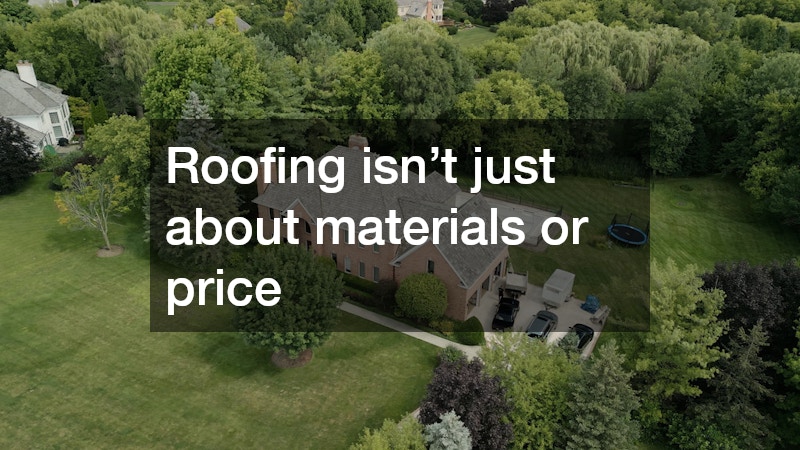
Replacing or repairing a roof isn’t something most homeowners do often. For many, it’s a once-in-a-generation project—something that feels both expensive and confusing. While most homeowners focus on costs and colors, professional roof installers see roofing projects from a very different perspective. They know what makes a job go smoothly, what issues commonly arise, and what can help homeowners make smarter decisions. Here’s what roof installers wish every homeowner knew before the first shingle goes up.
Your Roof Is a System, Not Just Shingles
A roof is much more than the visible layer of shingles or tiles. Professional roof installers know it’s an integrated system designed to protect your home from water, wind, and weather.
Beneath the outer layer are several crucial components: underlayment, flashing, ventilation, insulation, and sometimes an ice-and-water barrier.
When homeowners focus only on the surface materials, they may overlook the importance of these hidden layers. If one part of the system fails, the whole roof can underperform. For example, inadequate ventilation can cause shingles to age prematurely and encourage mold growth in the attic. Understanding that your roof is a complete system helps you see why installers emphasize balance and proper installation over just looks or price.
Preparation Makes or Breaks a Roofing Project
Many homeowners think the hard work begins once the shingles are delivered. In reality, successful roofing projects depend heavily on preparation. Roof installers wish homeowners understood how much time goes into planning, measuring, inspecting, and prepping before the first nail is driven.
This preparation often includes assessing the roof’s structure, checking for hidden damage, ensuring the deck is solid, and organizing safety equipment. Homeowners who rush this stage or hire crews that cut corners may end up facing delays, leaks, or unexpected expenses. A little patience and proper preparation can save a lot of frustration down the line.
Weather and Timing Really Matter
Roofing projects are at the mercy of the weather. Even if you schedule months in advance, unexpected rain or extreme heat can delay installation. Professional roof installers know that temperature and humidity affect how materials perform and how well they adhere.
While it can be inconvenient to reschedule, working in the wrong conditions risks poor results. Adhesives may not seal properly, shingles can warp, and moisture can get trapped. Homeowners who understand this are more likely to support their installers’ decision to wait for the right conditions rather than pushing for a rushed job.
Cheap Materials Can Cost You More Later
It’s tempting to save money by choosing the lowest-priced materials, but roof installers know that quality materials pay off in the long run. Cheaper shingles or underlayments often have shorter lifespans, weaker wind resistance, and lower energy efficiency. They might look fine at first, but fail sooner than expected, leading to more repairs or a premature replacement.
Professional installers also understand how well different materials perform in your local climate. For instance, what works well in a dry, mild region might not hold up under heavy rain or snow. Listening to their recommendations about materials is one of the smartest things a homeowner can do.
Roofing Is a Noisy, Messy Process
Many homeowners are surprised by how disruptive a roofing project can be. There will be hammering, debris, and vibrations that can rattle light fixtures or wall art. Roof installers know that preparation inside the home is just as important as outside—moving fragile items, parking vehicles away from the house, and warning neighbors can make the process smoother.
Installers also appreciate it when homeowners give them space to work safely. Staying indoors or away from the work area helps prevent accidents and lets the crew focus on getting the job done efficiently.
Ventilation and Insulation Are Just as Important as Shingles
One of the biggest misunderstandings homeowners have is that roofing only involves what you can see from the street. Roof installers know that proper attic ventilation and insulation are crucial for a roof’s performance. Without balanced airflow, heat and moisture build up, causing shingles to deteriorate and energy bills to rise.
When installers recommend adding vents or improving attic insulation, they’re not upselling—they’re protecting your investment. A well-ventilated roof lasts longer, stays cooler, and helps maintain comfortable indoor temperatures.
Professional roof installers don’t just replace shingles—they protect one of your home’s most important systems. Understanding what goes into a roofing project helps homeowners make informed decisions, set realistic expectations, and get the best possible results. When you see the process through the eyes of an installer, you’ll realize roofing isn’t just about materials or price—it’s about planning, precision, and long-term performance.




